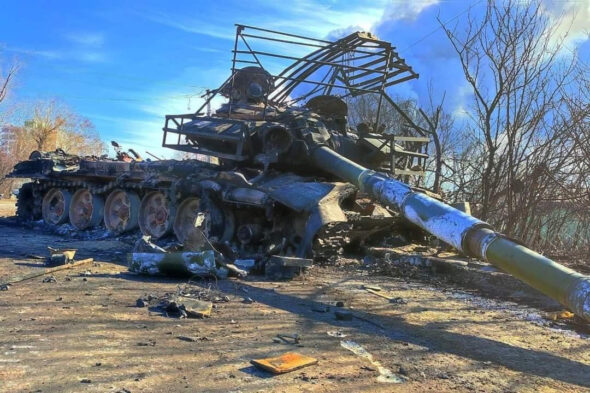The Russian army expected to march triumphantly into Kiev, while being cheered on by Ukrainians. However, it was met with fierce resistance, shame and humiliating defeats. The operation in Ukraine and its final course will have huge implications for Vladimir Putin, and this is the most worrying part of this whole story – writes Mariusz Marszałkowski, editor at BiznesAlert.pl.
Russia’s goal in Ukraine
Ukraine is in the sixth day of the „special operation” conducted by the Russian Federation. The official goal of this operation (the Russians avoid calling it a war) is the „denazification” and an armed disarmament of Ukraine. After such a period of hostilities, it is possible to retrace their course and try to assess their consequences.
The Russian army is estimated to have prepared for the invasion of Ukraine more than 130 BTGs, which have between 160 and 200 thousand soldiers. These troops include not only combat units, but also aviation, engineering troops, medics, logisticians, etc. The Russians attacked on February 24 at 4:15 am Moscow time, just after Putin’s address explaining the reasons behind the start of the „special operation”.
The invasion first began with a rocket attack – both from multiple rocket artillery systems, as well as ballistic missiles and self-propelled rockets fired from strategic bombers and ships of the Russian navy.
After carrying out an artillery and rocket „podgotovka” mechanized infantry stepped into action. First the attack was directed at Kharkiv, Chernihiv, the Ukrainian areas in the Donbas, with particular emphasis on Stanytsia Luhanska, Volnovakha and Mariupol. Russian troops also left the occupied Crimea and headed in two directions. The first attack went to Kakhovka and Kherson. In Kakhovka there is an outlet of the Kachovsky reservoir, from which water had been supplied to the Crimean peninsula through the north Crimean Canal. In 2014 Ukrainians built a dam to block the channel. For many years it has been said that a potential Russian strike on this place first. The second thrust of the „Crimean front” was directed to the east, in the direction of Melitopol and Berdyansk. This direction is important for encircling the Ukrainian forces located on the coast of the Sea of Azov, and later, depending on the success of the operation, also for directing strikes to the north, in the direction of Zaporozhye and eventually connecting with Russian forces moving from Kharkov and Sumy to the south. Such a scenario would cut off the Ukrainian forces in Donbas, and create a „pot” from which escape would be impossible. It would also mean that Russia took hold of the entire region east of the Dnieper, i.e. the Left-bank Ukraine.
In addition to these advances, already on the first day of the war the Russians launched a helicopter raid on the Gostomel airport, located 15 km from the center of Kyiv. The goal was to take over several Il-76 planes on the airstrip in the later phase of the operation, this was to be done in cooperation with the Russian offensive that had been expected to take over Kyiv on the first day. The Russian helicopter landing was carried out by about 200 soldiers, who were transported to the site onboard more than 30 Mi-8 helicopters (plus a few Ka-52 escort helicopters). During the attack the Russians certainly lost two helicopters (there is photo and video evidence of this). One assault Ka-52 and one Mi-8AMTsz, which fell into the Dnieper before reaching the target.
This attack was to lead to the seizure of Kyiv during the first 24 hours of the operation. After that, the Russians planned to change the leadership of Ukraine to one that will pursue their interests. This, in turn, was to end the hostilities and allow the Russian troops to return in glory and triumph, without incurring major losses. However, the reality turned out to be brutal.
Russian victories and defeats
In general, the Russians are relatively successful only on the southern and eastern fronts . The separatists, who receive Russian equipment and support from the air and on the ground, managed, after heavy fighting, to break through the Ukrainian defence line in the Donbas. Their forces entered tens of kilometers into the Ukrainian territory. Also in the Crimean direction, Russian troops managed to approach Kherson, occupy Melitopol and Beredansk and almost encircle Mariupol. The successes in the southern sector are due to the smaller concentration of Ukrainian defenders in the area, and the unfavourable terrain, which rewards offensive actions over defensive ones.
In the other directions, the most important from the point of view of the defense of Ukraine, the Russians are suffering a crushing defeat. Ukrainians stand little chance against armor, especially since the Russians have advantage in the air, but despite hundreds of missiles launched (according to US data as at February 27, it was more than 330 ballistic and maneuvering missiles), the Russians failed to win absolute air superiority, and their armored forces are incomparably larger and more modern.
The Ukrainian tactics turned out to be fully adapted to the realities in which they have to fight. The Ukrainians allowed the Russian armoured divisions to enter deep into their territory, while at the same time ruthlessly eliminated the supply columns behind them – with spare parts, engineering subdivisions, fuel and ammunition. Consequently, the self-assured Russian military columns had to stay on the side of the road without fuel and other supplies. These columns are then either destroyed by Ukrainian aircraft, including Turkish TB2 Bayratkar unmanned aerial vehicles, or by artillery fire. Increasingly, as a result of low morale, Russian soldiers themselves leave their vehicles and flee on foot. After a few days of fighting, the Russians, only based on video evidence, lost more than 100 tanks and armored vehicles. In addition, several hundred trucks, cars, tank trucks and other support equipment were destroyed.
But the massacre of Russian military equipment is not the worst thing that is happening to the Russians on the Ukrainian front. The operation, which they thought would be a walk in the park, has turned into a massacre of Russian soldiers. According to the Ukrainian general staff by 28 February in Ukraine 5,200 Russian soldiers died. The data from Ukraine should be approached with caution, but the recordings and videos from the front, clearly show that today, not even a week after the start of the military operation, the Russians have certainly lost more than 3 thousand soldiers, some of whom were killed, wounded or captured. This is a huge loss for the Russian army. It is worth comparing the current losses (still unfinished conflict) with those recorded in wars in the past in which Russia participated. In the Soviet-Afghan war, which lasted from 1979 to 1989, between 14 and 28 thousand Soviet soldiers died. In the first Chechen war, which lasted from December 1994 to September 1996, from 5 to 14 thousand Russian soldiers were killed. In the second Chechen war, which took place from October 1999 to June 2000, between 3 and 7 thousand soldiers and officers of the Russian army died.
The current war in Ukraine has been referred to by some as the second Afghanistan from the very beginning. However, if a ceasefire is not reached quickly and the Russians do not change their strategy, Afghanistan will be quickly dethroned.
Russian troops are yet to get hold of a major urban center. The invading forces are trying to avoid entering cities. Instead, they drive around them. This causes the supply lines to be stretched and exposes them to infiltration by Ukrainian forces. In addition, the Russians are unable to develop air superiority, despite conducting regular air raids on Ukrainian targets. It is very telling that Ukrainian cities, including those that are being bombed, still have internet and phone access. This makes it possible to disseminate information on the movement of troops and ongoing raids, as well as communicating with the cities that are cut off from the rest of the country. This means that Russia’s Electronic Warfare Capabilities are not as effective as they seemed to be before the war.
The same goes for the myth about the „no-access zone” created by the Russian anti-aircraft systems, which was developed by some communities, also in Poland. Despite the the fact it was expanded by long-range zones created by the S-400, S-300W, medium-range like BUK or short-range like Tor, Tunguska, Pancyr-S or Strelka-10 systems, Ukrainian aircraft and helicopters continue to perform their assigned tasks. If Russia’s air defenses were indeed as tight as the Russians and some Western experts had pointed out, the Ukrainian air force, if not destroyed on the airfield’s tarmac, would have disappeared in the first hours of the war while performing tasks over Ukraine. However, this did not happen.
What distinguishes the current conflict from the one in 2014 and 2015 is the very high level of OPSEC, or operations security on both sides of the conflict. In 2014, every shot fired from a BM-21 GRAD launcher, every shot fired from howitzers or tanks was meticulously documented on soldiers’ mobile phones and sent into virtual space. The same pertained to the passage of military columns or other military actions. Today, after five days of fighting, recordings of battles, shelling or troop movements crop up sporadically, especially when it comes to content from the military. The information about casualties or possible shelling is provided by civilians and others not involved in direct hostilities. This is one of the biggest changes in contrast to the beginning of the conflict in the Donbas. This is particularly evident on the Ukrainian side, where the society itself is disciplined about recording military columns or the soldiers themselves.
What also draws attention in this conflict is the incredible sacrifice of the Ukrainians themselves. And I’m not just talking about the masses that are joining the territorial defense forces or the fact that no-one is avoiding mobilization. It’s also about action, including preparing the defense of cities, building dams, making Molotov cocktails or teaching others to use weapons. The involvement of civilians in blocking the movement of Russian military columns is also impressive.
In contrast, the Russian troops are demoralized, they lack motivation, the desire to fight for a cause that is lost. Especially when the soldiers see how the locals treat them. Those, according to the Kremlin were to welcome the Russian army as liberators and friends. They greet them instead with Molotov cocktails and insults. Russian soldiers were supposed to meet bloodthirsty Nazis, and they meet people who often speak their language, and who are just like them. All this makes the will to fight on the Russian side negligible. Hence the numerous cases of desertion, abandonment of equipment or other forms of insubordination.
Pyrrhic victory or total embarrassment?
Despite the fact that the Russian army has not yet fulfilled the hopes of the Russian leadership, it must not be underestimated. According to data provided by American intelligence, so far about 100 thousand soldiers, i.e. about half of the baseline, are active in Ukraine. In addition, the Russians are still strengthening the reserves and sending more equipment. The Russian operation has already failed, because it was supposed to be a bloodless repetition of the annexation of Crimea in 2014. That’s not what happened. The Ukrainians resisted, the Russian commanders showed indolence, the Russian intelligence underestimated the potential of Ukraine. Despite this, Russia still has the potential to act, and calming the front and more cautious action can bring the desired results. This can be seen on the southern front, which is slowly moving to the detriment of Ukraine.
Much can also change if Belarus joins the war, or if a second front in the north, near the border with Poland, is opened. On the one hand, this will bind the Ukrainian forces, which could instead go from the cut-off to the south, or to Kyiv, on the other hand, in the worst case scenario, it can lead to the cut-off of access to the constantly flowing support from the West.
Putin has nothing to lose. The losses are already enormous, withdrawal without a clear success will mean his end in Russia. Given that he has made many enemies during his more than 20 years in power, the slip he has made over Ukraine could be disastrous for him. The Russian media are already hinting at a possible partial mobilization, which may indicate the desire to fight to the „last drop of blood”. The last blood of Russian soldiers, otherwise the last blood that can flow will be the blood of Putin himself. This may be worrying, because the attack on Ukraine has shown that, in addition to a lack of imagination and reason, he is also characterized by insanity. It is difficult to ignore this in the face of the arsenal that the state he leads has.









